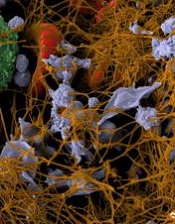
Credit: Andre E.X. Brown
A next-generation bioreactor can produce fully functional platelets, according to research published in Blood.
The bioreactor recapitulates human bone marrow and blood vessel microenvironments.
And when the researchers introduced megakaryocytes derived from human induced pluripotent stem cell cultures (hiPSC-MKs), the bioreactor produced platelets with the structural and functional properties of natural platelets.
The team said this work is a major advancement that could help address blood transfusion needs worldwide.
“The ability to generate an alternative source of functional human platelets with virtually no disease transmission represents a paradigm shift in how we collect platelets that may allow us to meet the growing need for blood transfusions,” said lead study author Jonathan Thon, PhD, of Brigham and Women’s Hospital in Boston.
His group’s bioreactor uses biologically inspired engineering to fully integrate the major components of bone marrow, modeling both its composition and blood flow characteristics.
The bioreactor recapitulates features such as bone marrow stiffness, extracellular matrix composition, micro-channel size, and blood flow stability under high-resolution live-cell microscopy to make human platelets.
“[B]eing able to develop a device that successfully models bone marrow represents a crucial bridge connecting our understanding of the physiological triggers of platelet formation to support drug development and scale platelet production,” said senior study author Joseph Italiano, Jr, PhD, also of Brigham and Women’s Hospital.
He and his colleagues showed that physiological shear stresses in the bioreactor triggered proplatelet initiation, reproduced ex vivo bone marrow proplatelet production, and generated functional platelets.
In static culture, hiPSC-MKs began producing proplatelets at 6 hours post-isolation and reached maximal production at 18 hours. However, hiPSC-MKs under physiological shear stress began producing proplatelets immediately upon trapping and extended/released proplatelets within the first 2 hours of culture.
About 90% of hiPSC-MKs under shear stress produced proplatelets, compared to 10% of hiPSC-MKs in static cultures.
The hiPSC-MK-derived bioreactor platelets displayed forward scatter, side scatter, and surface biomarker expression characteristic of human platelets. Electron microscopy showed the 2 types of platelets were ultrastructurally indistinguishable from one another.
Furthermore, bioreactor platelets displayed morphology and microtubule expression comparable to human platelets. And bioreactor platelets spread normally upon contact-activation with glass, forming both filpodia and lamellipodia.
“Bioreactor-derived platelets theoretically have several advantages over conventional, donor-derived platelets in terms of safety and resource utilization,” said William Savage, MD, PhD, medical director at Kraft Family Blood Donor Center at Brigham and Women’s Hospital, who did not contribute to the study.
“A major factor that has limited our ability to compare bioreactor platelets to donor platelets is the inefficiency of growing platelets, a problem that slows progress of clinical research. This study addresses that gap, while contributing to our understanding of platelet biology at the same time.”
Based on the promising results of this study, the researchers would like to begin clinical trials testing the bioreactor platelets in 2017.
“The regulatory bar is appropriately set high for blood products,” Dr Thon said. “And it is important to us that we show platelet quality, function, and safety over these next 3 years, since we’ll likely be recipients of these platelets ourselves at some point.”

